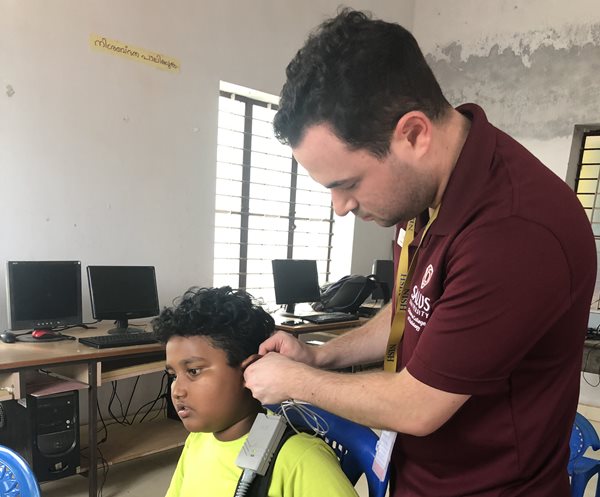If you can’t be with your family, spending Christmas Eve at the Taj Mahal could be considered the next best thing.
That’s just what some students in the University’s Osborne College of Audiology (OCA) did on the second leg of an international clinical experience trip to India at the end of last year. Three third-year students – Anna Demko, Troy Scanlon, and Payton Burke – joined Dr. Jenny Rajan, OCA assistant professor, for clinical training at the National Institute of Speech and Hearing (NISH) Dec. 16 through Dec. 19 in Trivandrum, India.
 Prior to the trip, students created goals for the following areas: clinical, personal and cultural. In addition, students kept a daily reflection journal about their experiences.
Prior to the trip, students created goals for the following areas: clinical, personal and cultural. In addition, students kept a daily reflection journal about their experiences.
The students gained hands-on experience performing screenings, diagnostic assessments and creating custom ear molds. Students also learned about cochlear implant mapping, had the opportunity to interact with deaf/hard of hearing individuals via Indian Sign Language and American Sign Language and taught some vestibular test procedures.
“It was amazing to see the similarities as well as some of the differences,” said Demko. “We thought maybe they do things differently. I think we were surprised to know that everything was essentially the same.”
The experience of working at NISH proved to be an invaluable experience to the students. Over the course of five days, the students worked in the audiology clinic performing diagnostic evaluations on both children and adults. The students also went to a hospital and conducted newborn hearing screenings as well as a primary school, where they screened 63 children in one afternoon. This was an extremely rewarding experience as students had the opportunity to interact with the children and speak some Malayalam, the language of Kerala, with them.
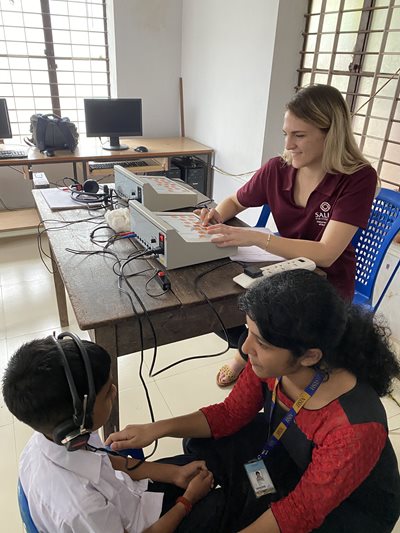 “I think one of the biggest things about NISH is its interprofessional communication,” said Burke. “So patients don’t go just for a hearing test, get a hearing aid and call it a day. All of it is incorporated together so that the professionals work together.” If a need is identified for auxiliary services, such as speech/language therapy, occupational therapy, physical therapy, social work, psychology, or for an ear-nose-throat physician, NISH is able to provide those services in-house.
“I think one of the biggest things about NISH is its interprofessional communication,” said Burke. “So patients don’t go just for a hearing test, get a hearing aid and call it a day. All of it is incorporated together so that the professionals work together.” If a need is identified for auxiliary services, such as speech/language therapy, occupational therapy, physical therapy, social work, psychology, or for an ear-nose-throat physician, NISH is able to provide those services in-house.
Burke added that the education pathway for Indian students is a little different than it is for Salus students. NISH has a school that offers both bachelor’s and master’s programs as well as a clinic. Bachelor’s and master’s students work in a clinic, similar to how Salus students work at the Pennsylvania Ear Institute (PEI), The Eye Institute (TEI)and the Speech-Language Institute (SLI). But in India, there are no separate audiology and speech degrees, it’s a dual degree.
“So they start from the time they’re in their bachelor’s program learning audiology and speech. They don’t take any other general education courses. It’s specialized from the start. The entry level to practice audiology in India is a bachelor’s degree. There is also the option to obtain a master’s degree,” said Burke.
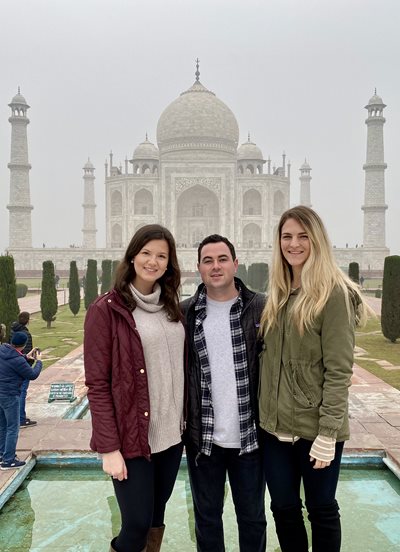 One twist for the students was being introduced to Indian sign language. Demko had no extensive experience with American Sign Language, other than to know some of the simple ABCs and number signs. Burke, on the other hand, had taken sign language as her foreign language in high school and then had followed that up with a couple more years of sign language during her undergraduate.
One twist for the students was being introduced to Indian sign language. Demko had no extensive experience with American Sign Language, other than to know some of the simple ABCs and number signs. Burke, on the other hand, had taken sign language as her foreign language in high school and then had followed that up with a couple more years of sign language during her undergraduate.
“I was a little rusty, so going into it I had to work out some of the kinks,” said Burke. “One of the main differences between Indian and American sign languages is that we do our whole alphabet on one hand in English and they use two hands.”
Even more cultural differences were apparent to the students as the first week progressed.
“I think we learned a lot about cultural differences, in and out of the clinic,” said Demko. “In the clinic there were tons of people in one room at the same time. Huge families would go in all together. It’s a big family affair when you go to a doctor’s appointment there. People would go there with their kids, and if their kids needed treatment, they would move to NISH and would be housed there. They’re very dedicated to the treatments and outcomes of their children.”
The way the different healthcare professions worked together was particularly apparent to the students.
“It wasn’t like a clear divide between professions. They really had a hand in a lot of different things, which I think that the U.S. should really adapt to. It was incredible to see,” said Burke.
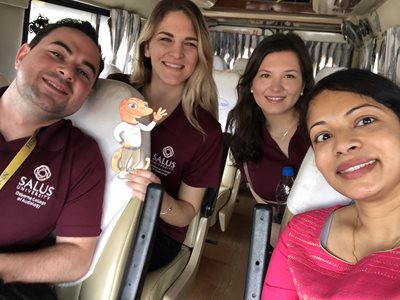 After their clinical week was completed, the students stayed for another week to tour some of the India sights, which would keep them in the country through Christmas Day. They traveled from the NISH clinic in the southernmost part of India to the northern part of the country, where they were able to visit Jaipur, the largest city in in the state of Rajasthan; New Delhi, and Agra, where the Taj Mahal is located.
After their clinical week was completed, the students stayed for another week to tour some of the India sights, which would keep them in the country through Christmas Day. They traveled from the NISH clinic in the southernmost part of India to the northern part of the country, where they were able to visit Jaipur, the largest city in in the state of Rajasthan; New Delhi, and Agra, where the Taj Mahal is located.
While in Jaipur, which is known as the “Pink City,” the students visited the Galt Ji Temple, which featured wild monkeys running free; toured City Palace, which is connected to the palace which currently houses the Indian royal family; and had the opportunity to ride elephants in the city of Amber Fort.
The original plan was to see the sun rise over the Taj Mahal on Christmas Eve in Agra. But the weather didn’t cooperate. During the winter months, India has a lot of fog and smog, so the students couldn’t see the sun rise that morning.
“Some of the fog had burned off later in the day and we were able to see the Taj Mahal,” said Burke. “There weren’t a lot of people there that day so we did end up spending Christmas Eve at the Taj Mahal.”
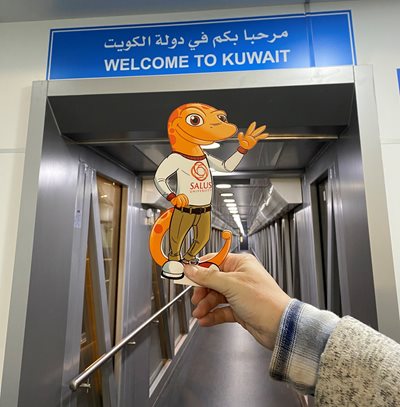 The other slight blip at the Taj Mahal was that the University’s mascot “Sal” the Salamander – an eight-inch tall plastic image of the mascot that can be borrowed from the communications department to travel the world and have its picture taken in different locations, was denied access into the Taj Mahal because he couldn’t get past security.
The other slight blip at the Taj Mahal was that the University’s mascot “Sal” the Salamander – an eight-inch tall plastic image of the mascot that can be borrowed from the communications department to travel the world and have its picture taken in different locations, was denied access into the Taj Mahal because he couldn’t get past security.
After the start of the semester, the students provided a presentation Jan. 27, 2020, that included an overview of their trip and shared their experiences with approximately 40 to 50 people from the University’s upper administration, OCA faculty, staff and students.
“Thank you to Dr. Radhika Aravamudhan, OCA dean, for providing this unique opportunity for OCA on-campus students, Dr. Jonette Owen, OCA assistant dean, for helping with the student selection criteria and process, the University’s Alumni Association for funding a portion of the trip for the students and last but not least to NISH for graciously hosting us this second time around,” said Dr. Rajan.
